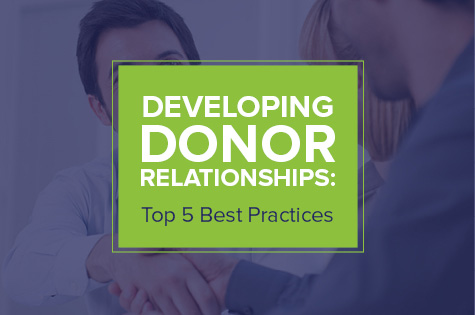
Nonprofits tend to have a bad habit of viewing their donors like piggy banks or ATMs, reaching out to them only when the organization needs funding for their newest project or impending shortfall.
While your donors are happy to help a good cause, in order to advance your mission through effective funding, you need to take your interactions with donors to the next level by building relationships. This is especially important during the age of COVID-19.
Continuing to show your supporters during difficult times (especially during economic hardship where they may not be able to contribute) that you still care about their well-being shows that you’re willing to stick by supporters’ sides through thick and thin. It’s the opposite of treating them like a personal piggy bank. They’re more likely to stick by your organization’s side for the long-haul in return.
Why is it important to develop relationships?
Developing relationships with your donors is the first step to enhancing your long-term fundraising strategy.
Having a relationship with supporters will help you cultivate lower-level supporters for higher giving levels, show your appreciation for support, and collect feedback about your services.
But how do you start this process? We’ve compiled our top five tips to developing relationships with your nonprofit’s supporters. These tips include:
- Get donors involved with organizational activities.
- Keep track of key donor metrics.
- Ask your donors for their advice.
- Don’t always ask for money.
- Keep interactions personal.
The first step to developing effective relationships is investing in a donor database designed for enhancing engagement. This will help you compile a donor-centric strategy from the outset of your interactions with supporters. From there, you can dive deeper into our strategies for relationship development.

1. Get donors involved in organizational activities.
Getting donors involved with the various activities and opportunities your nonprofit offers is our first tip to develop healthy relationships. It’s hard to build a relationship with an organization that supporters only interact with online. You miss out on heartfelt human interaction.
That’s why it’s important to encourage this human connection as much as possible. Donors should meet your key nonprofit players, such as your major gift officer, volunteers, board members, and executives.
To create these opportunities, we recommend that your nonprofit try the following strategies:
- Provide volunteer opportunities. Supporters are more likely to feel connected to your cause when they get to see it up close. Leveraging volunteer opportunities creates strong connections as supporters meet other passionate staff and volunteers. Plus, you’re accomplishing goals for your mission.
- Invite supporters to events. Pre-coronavirus events provided in-person opportunities to meet your team while everyone gathered together for a fun experience. Now, virtual events are all the rage! Your nonprofit can create these personal experiences and engage your supporters while they tune in from the comfort of their homes.
- Create engaging conversations. Simply talking to your donors is a great way to get them involved with your organization and help them feel more connected. We recommend calling your supporters so that they have a personal interaction and back-and-forth conversation with your team members. Ask for feedback, invite them to participate in virtual events, or simply inquire about their well-being in these conversations.
Make sure to keep track of your interactions with your supporters to help guide future communications. In order to do this, you’ll need access to a comprehensive donor database. You should be able to build out donor profiles with information about their event participation, donations, volunteer hours, feedback provided, and any and all communications. This will help guide communications and opportunities promoted in the future.

2. Keep track of key donor metrics.
As much as we wish we could provide the same level of attention to each and every one of our donors, many times we must prioritize. There’s just not enough time in the day to frequently engage in one-on-one conversations with every single supporter of your organization.
That doesn’t mean your engagement strategy shouldn’t incorporate outreach to every one of your supporters. Your mid-tier and major donors may simply demand more of your attention and virtual face-time than lower-level donors.
To understand who your top-priority donors are, you need access to some key donor metrics. For instance, you may look at data in a donor’s profile to indicate metrics like:
- Donation growth. Look to see how a supporter’s engagement has changed with your organization over time. Has their donation amount increased as they’ve gotten more involved?
- Engagement score. Some donor database software will provide an engagement score for each supporter, which takes into account their frequency of engagement, latest interaction, and more to show how involved they are with your nonprofit.
- Generosity score. A generosity score is calculated using prospect research. It provides an indication of the gift level a donor could reach based on wealth metrics like stock holdings, real estate, and business affiliations.
- Average gift size. While the generosity score is great to measure prospective donations, you should also be sure to look at the current average giving level to better understand where they are in their giving now.
- Gift frequency. Even if a donor is only giving you $5 or $10, the fact that they are doing so multiple times a year, or even monthly as a part of a recurring donation program, is a stronger engagement metric than a single annual gift of an equal amount.
Keep in mind that your lower-level donors now might have more capacity to give in the future. Therefore, they shouldn’t feel forgotten. Set up engaging email campaigns and invite them to engaging, community-wide virtual events to keep them involved with your initiatives.
Be sure to also conduct prospect research about your supporters. This will provide additional information that you can use to identify high-priority donors with great affinity to give. If you’re interested in learning more about research analytics that indicate a donor’s affinity to give, check out this guide.

3. Ask your donors for their advice.
Donors give to nonprofits because they value the work that the nonprofit does. However, you can’t expect this value to be one-sided. Just as your donors value your nonprofit, you need to show that you also value your supporters.
One key way to show that you value the input and opinions of your supporters is to ask for their advice and feedback.
This helps supporters get involved on another level because they have a say in the internal operations of your organization.
Plus, you may have supporters with skills that will fill some gaps in your nonprofit’s strategy. Consider the following examples:
- If your donors have ample marketing experience, they may be able to provide advice about your nonprofit’s outreach campaigns. Just be sure to maintain your brand in these campaigns.
- Maybe you have some tech-minded supporters who can help you revise and improve your website design for better visitor engagement.
- Donors may work as writers or designers, in which case you may recruit them to donate some time helping you edit promotional materials and communications for your nonprofit.
Discover details like this in conversation with your supporters or by analyzing their business affiliations. When you learn about this supporter information, be sure to save the data in the donor profiles in your nonprofit’s CRM.
If you’re looking for fundraising software that goes past raising money and will help guide your nonprofit through this key information, check out this buyer’s guide by Bloomerang.

4. Don’t always ask for money.
When nonprofits consider their interactions with supporters, they frequently only think about the last time they asked for money. Asking for donations over and over again may exhaust your donors.
When you’re reaching out to your supporters and really focusing on building relationships, you’ll have other goals for conversation besides just asking for more and more money.
Get creative with the types of communication you send to donors. For instance, you might choose to send messages about:
- Success stories. Tell those who give to your nonprofit about the impact their involvement has made for others. Success stories appeal to the emotional connection supporters have with your nonprofit.
- Advocacy opportunities. Ask for a different type of involvement. By signing a petition or participating in a click-to-call campaign, your supporters are helping your nonprofit without dipping into their wallets. For a guide on advocacy, check out Double the Donation’s resource.
- Relevant news. If there’s something in the news that directly pertains to your nonprofit’s mission, tell supporters about it! Make sure they feel good about supporting a nonprofit whose mission relates to a newsworthy cause.
- Upcoming events. Remind your supporters about upcoming virtual events and activities. If you are hosting a virtual event, tell supporters about the unique experience it will bring and how they can access your live streamed video.
- Volunteer opportunities. Tell supporters about the opportunities you offer to contribute time rather than money. This is an especially important strategy to engage your Millennial supporters, who tend to view contributions of time equally valuable as monetary contributions.
Asking for things other than money emphasizes to your supporters that your nonprofit prioritizes engagement first. It’s easy to view organizations that prioritize money as greedy or rapacious. However, those who focus on the engagement of supporters come across as more humane and caring about those who support them.

5. Keep interactions personal.
When you get into the nitty-gritty of communication with your supporters, one of the best ways to show them that you care is to make sure all messages have a personal touch.
This means that rather than sending the same message out to all of your supporters, you should make sure to include details in the communications that signal to the supporter that the message was intended specifically for them. Some strategies to incorporate these details include:
- Address donors by name in all communications. Make sure your software supports this idea. There’s nothing less personal than addressing a letter or email, “to whom it may concern.”
- Make personal notes about donors to pull into conversations. Keep notes in their profile in your donor database about family members, pets, and past interactions. This shows that you remember personal details about each individual supporter.
- Consider the trends in giving and marketing response so that when you reach out to supporters, you can offer them their preferred method of communication and preferred platforms for giving.
Personal interactions are how you show your supporters that you care about their individuality. While sometimes supporters may overlook these little steps, they’re sure to notice if you miss the opportunities for personalized messages.
Your supporters are much more than just piggy banks for your nonprofit. They provide the tools and support that you need to succeed. Building a relationship with them is a two-way street. Just as they work to get to know your nonprofit and your mission, you need to work to get to know them.
With these five tips, your organization is on its way to better functioning relationships with donors. Good luck!
About the Author: Jay Love

Co-Founder and current Chief Relationship Officer at Bloomerang
He has served this sector for 33 years and is considered the most well-known senior statesman whose advice is sought constantly.
Prior to Bloomerang, he was the CEO and Co-Founder of eTapestry for 11 years, which at the time was the leading SaaS technology company serving the charity sector. Jay and his team grew the company to more than 10,000 nonprofit clients, charting a decade of record growth.
He is a graduate of Butler University with a B.S. in Business Administration. Over the years, he has given more than 2,500 speeches around the world for the charity sector and is often the voice of new technology for fundraisers.